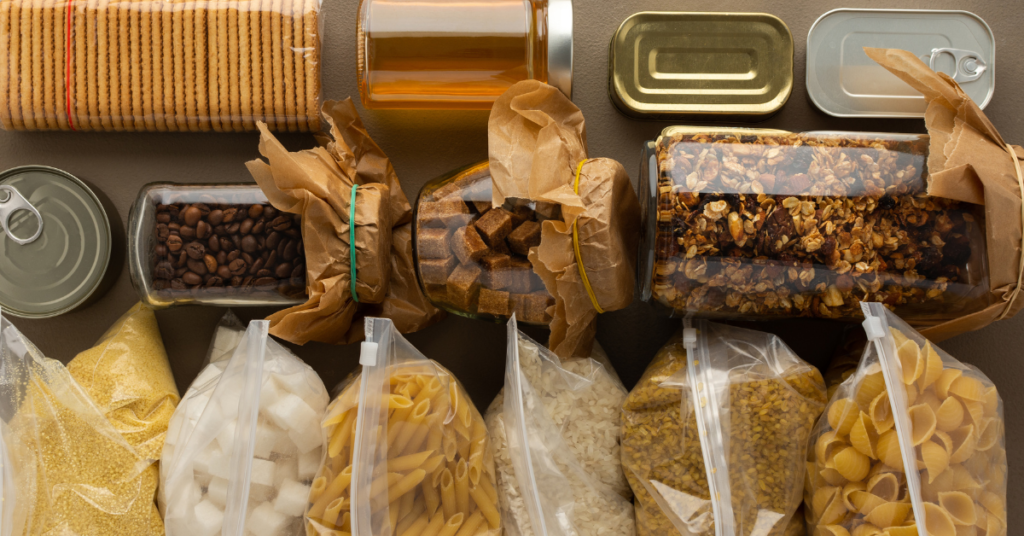Every family needs to prepare for emergencies and disasters. Besides having a plan in place, having enough food stored is essential. Ensuring enough food to last through a crisis is crucial for individuals who consider themselves preppers. However, how much food to store can take time and effort. Should people aim for a week-long or a month-long supply? This article will provide factual information on the required amount of food and guidance on what to consider when stockpiling food. Continue reading to learn more about how much food should a prepper have.
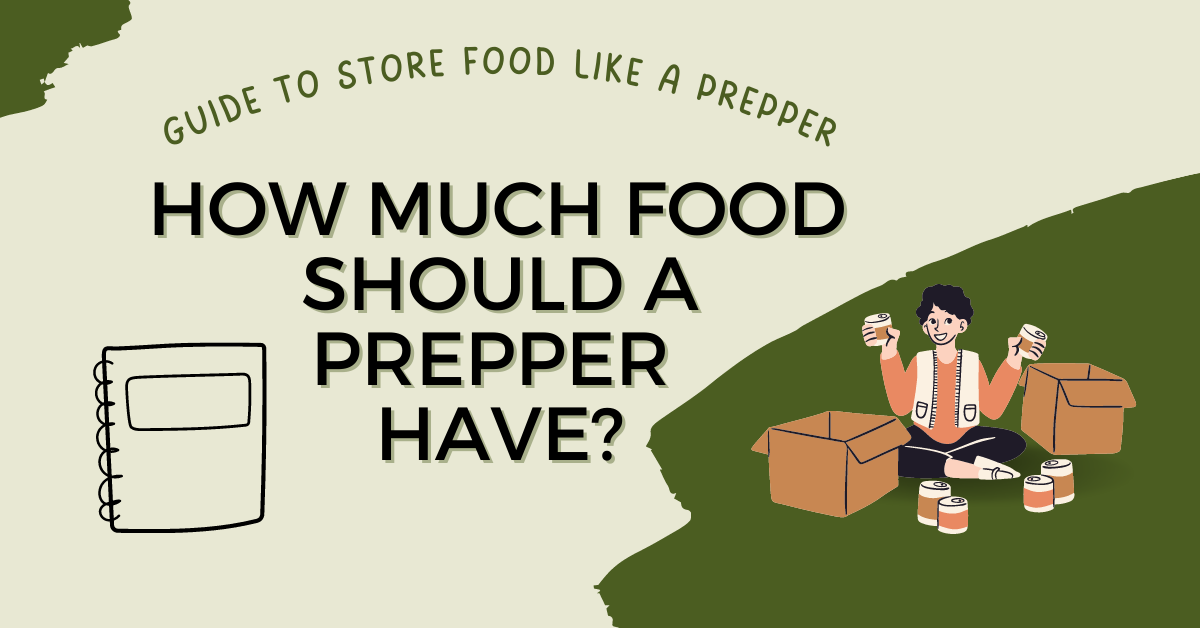
A Concise Summary of Prepping and The Significance of Accumulating Food Supply
Getting ready for disasters or emergencies is not unreasonable.
It is practical.
One of the vital actions in planning for disasters is storing food.
In this guide, we will go over the fundamentals of food preparation and how to select the appropriate survival rations for various situations. We will also talk about how to evaluate your food requirements on a day-to-day, weekly, and monthly basis.
To ensure you have sufficient food for brief and moderate emergencies, we will demonstrate how to assemble a 72-hour emergency kit and gather a food supply that lasts for 3 to 6 months.
For extended periods of food storage, we will advise on appropriate amounts and the most suitable types of food to store.
We will also consider factors related to food storage, such as non-food essentials, differences in requirements between adults and children, and the size of your group.
You will gain knowledge about the best techniques for storing food, such as increasing longevity and shelf life.
It’s essential to understand the significance of regularly rotating supplies and ways to increase the amount of stored food to avoid mistakes in preparing food. By following this advice, you can create a fully stocked pantry for emergencies that will ensure that both you and your family have ample nourishment.
#1 – The Basics of Food Prepping
Preppers need to have a pantry that’s adequately supplied, particularly with food. Below are the fundamentals that you must take into account for food prepping.
Prepper food items can be stored for extended periods without spoilage and are straightforward to cook while also crucial for maintaining vital nutrition during survival.
When deciding on foods for prepping, consider your family’s dietary limitations, likes, and allergies. Opt for foods that serve multiple purposes, like canned food, dried fruits and vegetables, and rice.
Evaluate your food preparation needs according to your daily, weekly, and monthly necessities. This will enable you to ascertain the quantity of food you must preserve.
For the immediate and not-too-distant future, it is advisable to have a 3-day emergency food kit and a 3-6 month supply of food. Consider the kinds of food you consume regularly and ensure to substitute your stockpile consistently.
When planning to store food for a long time, it’s essential to consider how much food storage will be needed and which types of food are most suitable for storage lasting over 12 months. This could involve choosing freeze-dried foods, canned food products, and large quantities of grains.
Additional factors to think about when storing food include:
- Items that are not edible.
- The differing requirements of children and adults.
- The size of the group being supplied.
It is important to ensure that food is stored in a location that is cool, dry, and devoid of light. It is also essential to consistently rotate, replace, and augment your food storage to keep it current.
What are the Best Beans for Prepping and Long-Term Storage?
When it comes to choosing and storing beans for prepping and long-term storage, go for durable options like black beans, pinto beans, and kidney beans. These varieties can withstand extended storage periods and retain their quality. Properly sealed containers in a cool, dark place are ideal for storing beans.
What Are The Characteristics of Prepper Foods and How Can They Be Selected Effectively?
To prepare for emergencies, knowing about the concept of “prepper foods” and their selection process is crucial. These types of foods should have an extended expiration date for long-term food storage, require little preparation, and be rich in nutrients. Below are suggestions on how to choose prepper foods.
Search for items that won’t spoil easily, such as canned goods, dehydrated fruits and vegetables, and grains like rice, quinoa, and oats.
When choosing what to buy, consider how long the food will last before it goes bad. Don’t pick things that will expire soon, and instead, make sure to choose ones that will last for a longer time.
Select simple-to-make food options, for instance, instant ramen noodles or canned soups.
Remember to have snacks and comforting food available to lift spirits in emergencies. Think about including things such as chocolate, hard candy, and trail mix.
Strive to consume a range of diverse foods that offer well-rounded nourishment. Make sure to incorporate a blend of proteins, carbohydrates, and fats.
Consider the dietary requirements and limitations of those in your household. Opt for food options that cater to any allergies or dietary constraints.
You can begin to gather a supply of prepper foods that will ensure you and your loved ones are properly nourished during difficult situations and times of crisis by adhering to these suggestions.
Food Preparation: Daily, Weekly, and Monthly
Preparing food is a crucial part of preparation. To guarantee that your loved ones have sufficient food in worst case scenario, you should calculate the required amount of food daily, weekly, and monthly. Here are a few things to remember:
Find out how many people are in your family and if anyone has specific food requirements. Take into account each member’s different ages and levels of physical activity.
Evaluate the duration for which you plan on hoarding food. For shorter periods of prepping, ranging from 72 hours to 6 months, you should be well-prepared for most natural calamities. However, if you intend to prep for a longer term, say 12 months or more, you can safeguard yourself against more severe and protracted crises.
Calculate how many calories you need each day depending on your family’s unique needs. Generally, adults require approximately 2,000-2,500 calories per day, whereas children require 1,200-1,800 daily calories.
Create a record of the types of food your household consumes regularly and approximate the quantities that will suffice for a week or a month. Verify that the list encompasses a variety of wholesome options.
Think about utilizing a tool like a food calculator to assist in figuring out the appropriate amount of food to keep in storage.
Consider the amount of storage space that you have and make any needed modifications.
By evaluating what you need to prepare food, you can guarantee that your loved ones have adequate sustenance to withstand unforeseen circumstances without experiencing any further pressure or anxiety. [1]
#2 – Provision of Food for a Limited Period of Time (ranging from 3 days up to half a year)
Prepares must have food storage to ensure that every family member has enough food in the short term in case of an emergency. To determine the right amount of food to stockpile for 72 hours to 6 months, an adult’s recommended calorie intake ranges from 2000-2500 per day. An emergency food supply calculator can be helpful in finding the minimum amount of food required for emergencies. Essential items like grains, canned or dried meats, fats and oils, milk and dairy, fruits, vegetables, and water should be included when creating a 72-hour emergency kit and a 3 to 6-month food stockpile. There are several tips available on short to medium-term food storage.
To avoid food spoilage or contamination, keep it in a place that is cool and dry.
Opt for food items that have a prolonged duration of preservation, such as canned products or food subject to freeze-drying.
Regularly switching out your stock will keep it from becoming stale and reduce the potential for wastage.
One option to keep your food supply current is to make a rotating pantry containing three months’ worth of your usual meals.
Make sure you have a sufficient amount of pure drinking water for your household.
By adhering to these recommendations, you can guarantee that your food supply for the near future is sufficient to handle any unforeseen situations. [2]
Forming a 3-day Survival Kit and a Stored Supply of Food for 3 to 6 Months
To prepare for an emergency, it is crucial to assemble a kit that can sustain you for 72 hours and store sufficient food for 3 to 6 months. To begin this process, follow these guidelines:
Evaluate your necessities:
- Take into account the number of individuals you are providing for and the duration of time which your provisions should sustain.
- Prepare for plausible circumstances, including natural calamities, unemployment, and blackouts.
- Determine the daily calorie intake per person by considering their age, gender, and physical activity. Check out this calorie calculator!
Acquire non-perishable foods:
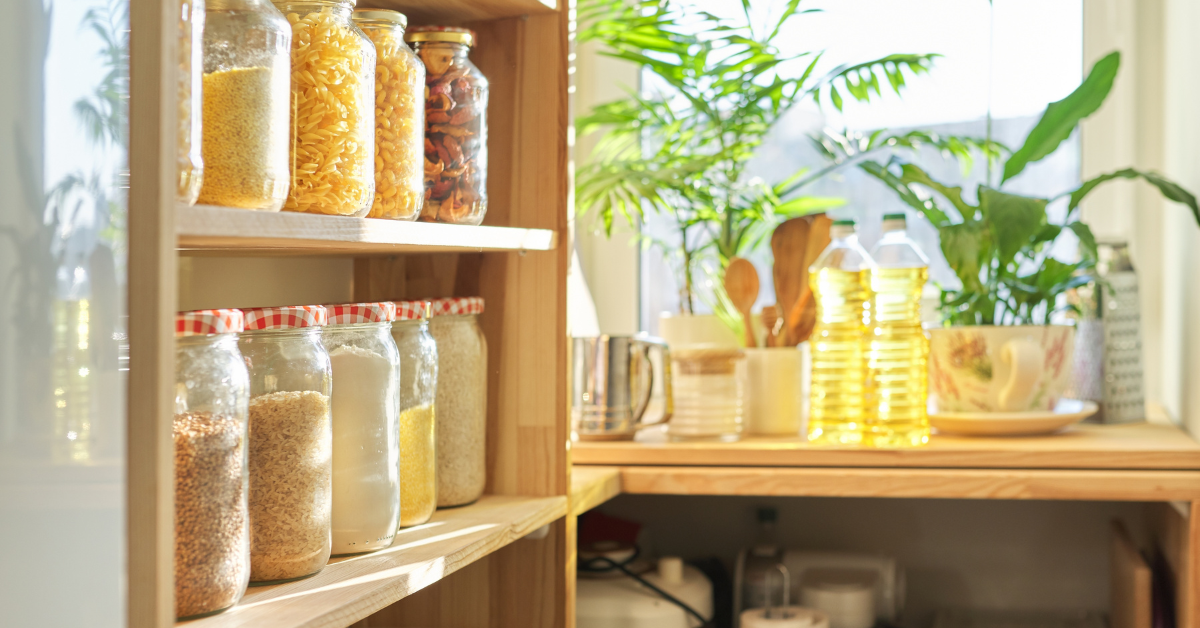
- Keep high-energy foods that will provide sustenance for a brief time in your emergency kit that lasts 72 hours, like preserved food, protein bars, and dehydrated items. In addition, for your stockpile of 3 to 6 months, include grains, canned or dried meats, fats and oils, dried beans, dry milk and dairy, fruits, vegetables, and other cooking basics.
- Ensure that you store foods with a lengthy shelf life or blend foods with a shorter shelf life into your regular diet to rotate supplies.
- Remember to include non-food items in your 72-hour emergency kit, such as garbage bags, moist towels, and plastic ties. Consider the needs of children, the size of your group, and any other non-food necessities when organizing your supplies.
- Make sure you store your supplies correctly by following proper storage techniques. This includes keeping your food in a cool, dry, and dark place and understanding how to prolong the shelf life of your supplies. Additionally, rotate your stockpile regularly to guarantee that your food remains fresh.
- Please pay attention to the usual errors: refrain from storing all your supplies in a single location and depending excessively on them. Instead, distribute your resources and complement them with fresh provisions as much as possible.
By adhering to these instructions, you will be able to produce a set of supplies to last for 72 hours in case of an emergency, as well as a sufficient food supply to last for 3-6 months to equip yourself for any potential natural disaster or crisis.
#3 – Long-Term Food Storage (12+ months)
If you are a prepper and want to store food for a long time, it is crucial to think about the nutritional value, shelf life, and amount needed. Below are some useful suggestions for successfully accumulating food for over a year.
To ensure an excellent long-term food supply, it’s vital to emphasize nutrient-rich foods that contain high amounts of vitamins, minerals, and protein. Excellent options include canned or dried fruits and vegetables and lean meats.
That your stored food lasts longer, keeping it in cool, dry, and dark surroundings is crucial. The use of oxygen absorbers can also assist in decreasing spoilage and the occurrence of insects.
Contemplate Buying in Large Quantities: Procuring food in large quantities could be beneficial for preserving food in the long run. Look for bargains and reduced prices on many non-perishable items such as rice, beans, and pasta.
To avoid food spoilage and wastage, it is crucial to implement a system of rotation. This system uses the oldest items first and consistently replaces them with new supplies.
Preppers can ensure their survival during critical times by taking into account these factors and storing food adequately for extended periods.
Optimal Amount and Ideal Varieties of Food to Store for Extended Periods
Knowing the appropriate amount and variety of food to store for emergencies that require prolonged storage. Below are the essential amounts and preferred kinds of food that should be considered for survival.
It is recommended to have sufficient amounts of food and water stored as part of emergency preparation or for natural disasters, ensuring that each person has access to at least 2000 calories of food and 1 gallon of water per day.
The Federal Emergency Management Agency recommends that each person’s 72-hour emergency kit should contain at least 6000 calories and 3 gallons of water in order to meet the minimum storage requirement.
Devise a strategy for your food provisions that considers the anticipated circumstances, the quantity of individuals requiring sustenance, and the duration of the crisis.
Select food items with high-calorie content that can provide sustenance over short and long periods. Examples of such food items include wheat, corn, beans, and salt, which can be bought in nitrogen-sealed cans and have an indefinite shelf life.
Add commercially packaged air-dried or freeze-dried foods, canned meats, rice, beans, dried fruits, ready-to-eat cereals, pasta mixes, rice mixes, and other supermarket products to your bulk staples.
Ensure you have enough vitamins, minerals, and protein supplements in storage for proper nutrition.
Infant formula, cereals, and baby foods for babies should be kept in the store.
Remember that the objective isn’t only to endure and prosper in a crisis. Strategize your food hoard intelligently. [3]
#4 – Food Storage Considerations
When thinking about how to store food, it’s crucial to look beyond how much food you need and consider other factors that could impact your preparation. There are several important things to keep in mind, including:
Not just food but it is also essential to think about keeping other necessities such as medical items, personal care products, and hygiene supplies.
Consider that children have distinct dietary requirements compared to adults, including varying food types and serving sizes. Provide a range of options to accommodate the needs of all individuals. Focus on providing enough calories.
Suppose you plan to prepare provisions for a bigger crowd like a family or society. In that case, you must modify the quantity of edibles you accumulate.
How you maintain and preserve your food can influence its durability and quality. Ensure you allocate it in cool and arid areas, and regularly replace your supplies to avoid spoilage.
When creating your stockpile, it’s crucial to consider how long different food items will last. For example, canned goods and dry grains tend to have a longer shelf life than other types of food.
Taking these factors into consideration will enable you to create a comprehensive and efficient food storage strategy that can help you stay prepared for any unexpected event or calamity.
In order to properly prepare food for emergencies or long-term storage, one must not only focus on what types and how much food storage but also consider non-food necessities, the different requirements of children versus adults, and the number of people involved.
Non-Food Items to Consider:
- Water storage and purification systems
- Cooking and heating equipment
- First aid supplies
- Hygiene supplies (Running out of toilet paper is annoying.)
- Personal care products like soap, toothpaste, and bathroom tissue are considered to be hygiene essentials.
- Communication tools such as a wireless transmitter like walkie-talkies or mobile phones.
- Power sources: It is recommended to keep multiple power sources in case one fails or runs out of power. There are multiple items to have during power outages: They provide illumination and help people navigate in the dark. In emergencies, such as natural disasters or severe weather conditions – also simple flashlights, and candles can be crucial for survival.
Get more informations about lightning sources in our article about the best power outage lights.
Children vs. Adults’ Needs:
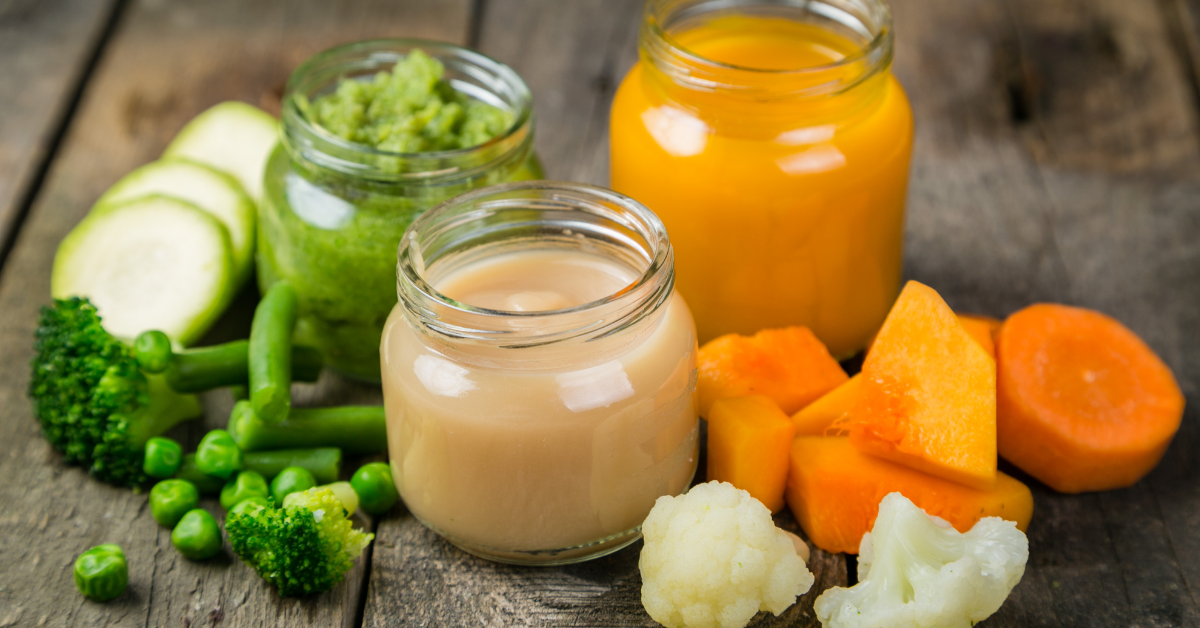
Kids generally need a diet rich in nutrients and well-balanced, as they are still growing and developing. While they need to consume fewer calories than adults, children’s diets must also provide adequate amounts of protein, calcium, vitamins, and other essential nutrients. Factors such as their age, gender, and level of physical activity can all affect their nutritional requirements.
Think about storing a supply of baby formula or other specific types of food for young children.
Store some soothing foods children enjoy to ease the tension during critical conditions.
Group Size Considerations:
When determining how much food and supplies to accumulate, consider the number of individuals in your household or group.
If you are planning to team up with another family or group during an emergency, modify your inventory accordingly.
Take into account these elements when you plan your food preparation, you will increase your readiness for any unexpected situation.
#5 – Guidelines for Properly Storing, Preserving Shelf Life, and Prolonging Freshness of Food
It is important to store food correctly to preserve its quality for as long as possible, particularly for those preparing for emergencies. Please follow these recommended methods for food storage to uphold its freshness and prolong its lifespan.
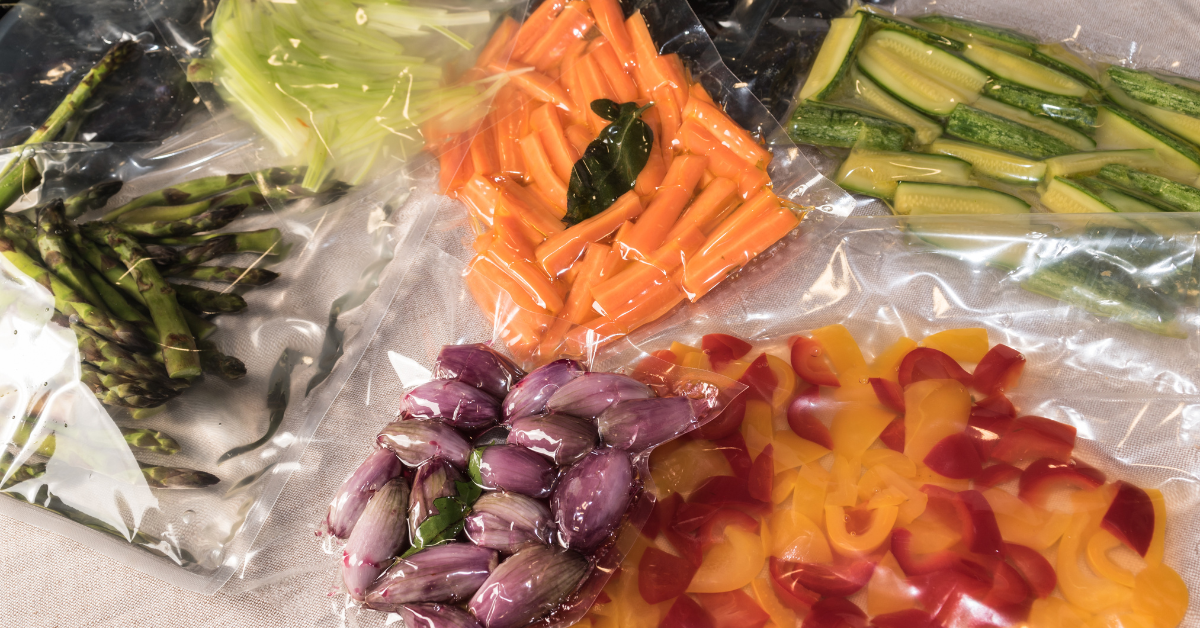
- To avoid food spoiling and the invasion of insects, keeping it in a cool and dry spot shielded from sunlight and moisture is recommended. It is recommended to employ sealed containers or bags that do not allow air to penetrate. You can use oxygen absorbers to eliminate the presence of oxygen inside the containers.
- To ensure freshness and proper rotation, mark your food items with either the purchase or expiration dates.
- To avoid contamination and unwelcome pests, keep your food storage area clean and well-organized.
- First-in-first-out: Regularly switch the items in your food supply so that you utilize the oldest ones first and ensure none are wasted.
- Think about buying a storage unit that regulates temperature, like a root cellar, cool closet, or freezer, to extend your goods’ lifespan beyond their usual timeframe.
- Make a list of all the food items you have and regularly update it so that you always have enough food for your requirements.
By adhering to these recommended methods of food storage, you can alleviate any concerns and have the reassurance that your prepping supplies are secure and trustworthy for future use.
#6 – The Significance of Rotating Stockpiles and Approaches for Expanding Them
Rotating your food inventory to keep your food fresh and avoid wastage is very important. The following are effective techniques to help you rotate your stockpile proficiently and gradually increase its size.
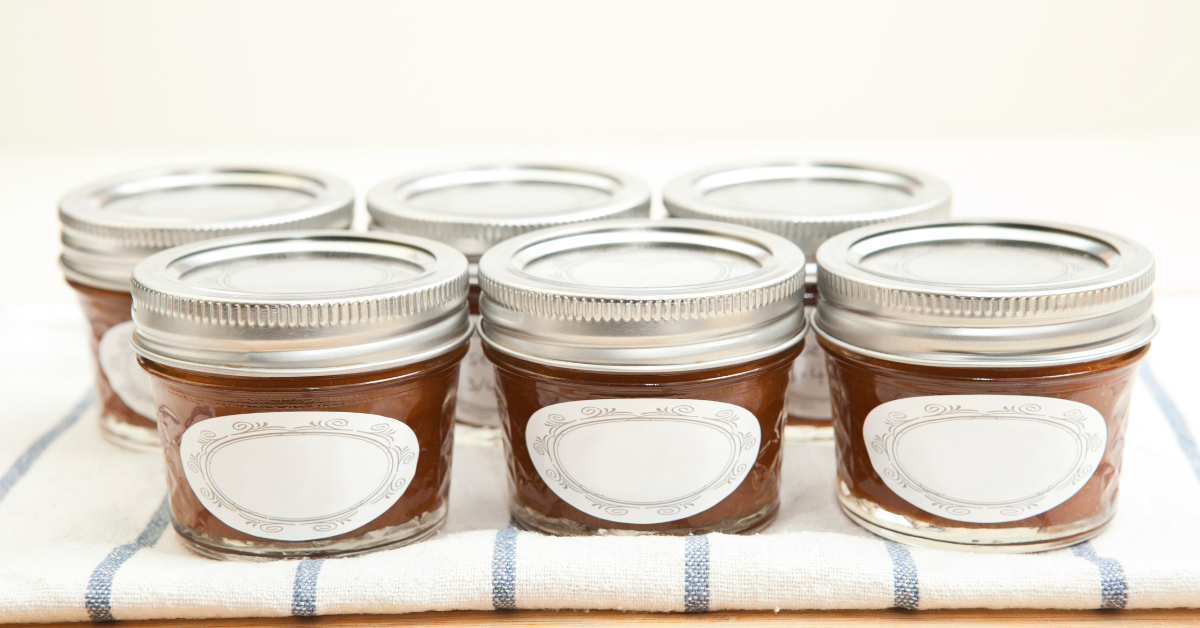
- Make a list of all the food you have in your supply, including the dates when they expire, and regularly update it.
- Prioritize the consumption of the oldest food items and dispose of them before they reach their expiration date. Keep track of the expiry dates of all food items and regularly replace expired ones with fresh ones.
- Monitor the amount of different foods you consume and make necessary adjustments to your supplies.
- Arrange your food items based on their category or expiry date to ensure that you can conveniently locate and consume them before their expiry date.
- Gradually increase your supply of provisions by establishing aims for the amount of comestibles you wish to gather and gradually incorporating them into your inventory.
- There are various ways to store your food, like using a vacuum sealer or mylar bags, which can help to make it last longer.
You can make sure that your stockpile stays new and well arranged and slowly enlarge it in preparation for probable crises by adhering to these tactics.
Conclusion
In summary, this article underscores the importance of emergency food preparation techniques.
We tried our best to give you an answer to the questing how much food should a prepper have – It depends on how many people you want to cover with food and how long.
Essential strategies include meal planning, correct storage methods, and understanding food preservation. Such practices ensure access to nutritious meals during crises.
Maintaining a well-stocked pantry for at least three months is advised, as it reduces costs, ensures food security, and decreases anxiety.
When choosing foods, preference should be for those with long shelf life and high nutrients. Consider the usage frequency to cater for daily to monthly needs, including non-edible essentials and catering to dietary requirements of all ages for every family member.
Short-term storage involves a 72-hour emergency kit; longer storage requires a three to six-month stockpile. For extended periods, high-quality foods with long shelf life should be accumulated.
Knowledge of food expiration, methods to extend it, and regular rotation of supplies are critical for effective storage. Avoid storing all supplies in one location or over-reliance on your stockpile.
In conclusion, food preparation is a crucial aspect of frugality. In unpredictable times, a well-prepared food stockpile offers comfort and reassurance to families.
Get started now to stock your pantry for emergencies!
